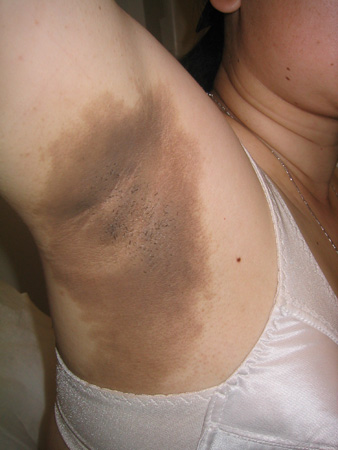History and exam
Key diagnostic factors
common
presence of risk factors
Key risk factors include premature adrenarche or a family history of polycystic ovary syndrome.
female of reproductive age
Symptoms typically start at the time of puberty. However, if oral contraceptives were begun at a young age, symptoms may be masked until therapy is stopped, which may delay the presentation and diagnosis.
irregular menstruation
Irregular menses is a common manifestation of oligo- or anovulation, occurring in 75% of women with polycystic ovary syndrome (PCOS). Guidelines from the International PCOS Network define irregular menstrual cycles as follows: <21 or >45 days for those 1 to <3 years post menarche; <21 or >35 days or <8 cycles per year for those ≥3 years post menarche to perimenopause; >90 days for any one cycle for those 1 year post menarche; primary amenorrhoea by age 15 years or >3 years after breast development.[53] Irregular menstruation is normal in the first year post menarche.
Women with regular periods may also have anovulatory cycles. Up to 40% of hirsute regularly menstruating women have anovulatory cycles when further investigated.[3]
As women with PCOS age (i.e., >30 years), cycle length may shorten and some women may experience regular cycles.[69]
infertility
Often a presenting complaint.
hirsutism
Present in 60% of women with polycystic ovary syndrome.[3]
Hirsutism is the presence of terminal hairs (thick, pigmented) in androgen-dependent areas (upper lip, chin, chest, back, upper arm, shoulders, linea alba, peri-umbilical region, thigh, buttocks). Hirsutism can be quantified using the modified Ferriman-Gallwey score, with levels ≥4-6 indicating hirsutism.[53]
It is not to be confused with hyper-trichosis (diffuse vellus hairs).
Some ethnic groups, particularly East Asians, are less prone to express hirsutism.[7][70]
It is important to ask about excess hair growth, because women often use methods of mechanical or local hair removal. Thus, the physical examination may not disclose hirsutism.
Other diagnostic factors
common
acne
May be masked by acne therapy. Acne is present in 15% to 25% of women with polycystic ovary syndrome (PCOS).[3]
Severe acne persisting beyond adolescence may be more indicative of PCOS.
Acne is a non-specific feature; many women with acne will not have PCOS.
overweight or obesity
Depending on culture and ancestry, 30% to 80% of women with polycystic ovary syndrome (PCOS) are overweight or obese, with central obesity (waist-to-hip ratio >0.85 or waist circumference >88 cm).
Body mass index and waist circumference should be assessed in all women with PCOS.[57]
hypertension
Non-specific, but commonly seen.
Blood pressure should be measured in all women with polycystic ovary syndrome.[57]
uncommon
scalp hair loss
The exact prevalence of alopecia in polycystic ovary syndrome (PCOS) is unknown, but may be as low as 5%.[3]
It is not a specific symptom, because many other disorders can cause alopecia.
Typically, scalp hair loss in PCOS is at the vertex and crown, with relatively intact frontal hairline. Hair on the sides of the head may be preserved.
oily skin or excessive sweating
Hyper-hidrosis and/or seborrhoea may be a manifestation of hyper-androgenism.
The exact prevalence of such symptoms in polycystic ovary syndrome is not known.
acanthosis nigricans
Usually subtle. Seen more often in obese women with polycystic ovary syndrome. This is a reflection of hyperinsulinaemia. [Figure caption and citation for the preceding image starts]: Acanthosis nigricans involving the axilla of an obese white womanFrom the collection of Melvin Chiu, MD, UCLA; used with permission [Citation ends].
Acanthosis nigricans is dermal hyperplasia visible as brown or grey, velvety, occasionally verrucous, hyperpigmented areas over the nape of the neck, also the vulva, axillae, groin, umbilicus, sub-mammary areas, elbows, and knuckles. Skin tags are often found in the neck area also.
In the US, it has been noted that obese black and Hispanic women tend to have clinical acanthosis nigricans.
Other causes include diabetes, excess corticosteroids or growth hormone (endogenous or exogenous), nicotinic acid, or gastric adenocarcinoma.
Risk factors
strong
family history of PCOS
premature adrenarche
Premature adrenarche (early onset of pubic/axillary hair and apocrine sweat gland development) is followed by development of PCOS in up to 50% of cases.[35]
obesity
weak
low birth weight
Might predispose to development of hyper-androgenism later in life by predisposing to premature adrenarche and hyperinsulinaemia.[39][40][41] One national registry-based cohort study found that being born small for gestational age as a risk factor for future PCOS was mediated by maternal obesity and smoking.[42]
fetal androgen exposure
Daughters of women with congenital adrenal virilising disorders may develop features of hyper-androgenism.[43]
The fact that PCOS did not occur more frequently in females with a male co-twin than in females with a female co-twin argues against fetal androgen exposure as a major factor in the development of PCOS.[44] Studies of umbilical cord blood of infants born to women with PCOS have yielded conflicting results, such as no elevation in androgen levels, or testosterone levels similar to male cord blood.[45][46]
environmental endocrine disruptors
Use of this content is subject to our disclaimer